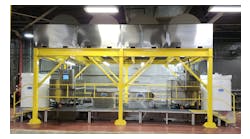By John K. Steckel Jr.
The City of Allentown (PA) Wastewater Treatment Plant has begun a project to reduce energy and operational costs by using microturbine technology to convert biogas into electricity and heat for use in the treatment process.
The 40 mgd Allentown wastewater treatment plant serves all or parts of 14 townships and boroughs in addition to the City of Allentown. The total population in the area served is about 195,000. The plant's biogas is collected from two primary digesters and one secondary digester. Each digester is 80 feet in diameter and is a floating-cover type, equipped with a gas recirculation system for mixing. The external heating system maintains the primary digesters at about 100degreesF and the secondary digester at about 80°F.
PPL Spectrum - a subsidiary of PPL Corp. - is working with the city on the project, which has the goal of supplying about 18 percent of the plant's electrical power. Design work began in September 2000 and construction started in November. Equipment was delivered in mid-December. Work continues as of this date. The system is expected to be fully on-line by the end of February 2001.
The City of Allentown Wastewater Treatment Plant plans to install 12 microturbines manufactured by Capstone Turbine Corp. Each unit is capable of converting biogas into 30 kW of electric power.
Samples of the gas produced in the digesters were analyzed to determine composition by volume and BTU content. The gas composition was about 65 percent CH4 and about 30 percent CO2. The BTU calculation resulted in a value of about 630 BTU per cubic foot.
Plant personnel take daily readings of the gas volume produced in the digesters. For this project, calendar year 1999 was used as the baseline period. Daily gas production ranged from 144,000 cubic feet to 309,200 cubic feet. Annual production was slightly more than 78.6 million cubic feet, or an average of 215,300 cubic feet per day.
Currently, the treatment plant uses digester gas for heating sludge and for heating several plant buildings. The plant has two large dual-fuel (methane and natural gas) boilers that provide hot water for sludge heating, and three smaller dual-fuel boilers for building heat. When sufficient digester gas is not available to meet the loads, the plant uses natural gas. About 35 percent of the gas produced was used for heating in 1999. The remaining 65 percent was sent to two waste burners on the roof of the digester control building.
During the baseline period, the plant's electrical demand varied from 1,275 kW to 2,325 kW. Values above 1,500 kW occur rarely and for short periods when flows are high due to rain. Annual electricity consumption was 13.7 million kilowatt-hours and cost was $850,000, resulting in a blended average cost of 6.2 cents per kilowatt-hour. During the same period, annual natural gas consumption was 20,750 therms at a cost of $16,600. Average cost of gas was 80 cents per therm.
Microturbine Technology
The generating equipment selected for this application is manufactured by Capstone Turbine Corp. A total of 12 systems are being installed at the treatment plant. Each system is a compact, low-emission power generator capable of providing up to 30 kW of electric power. Each system incorporates a compressor, recuperator, combustor, turbine and permanent magnet generator. The rotating components are mounted on a single shaft, supported by patented air bearings that rotate at up to 96,000 rpm. The generator is cooled by airflow into the gas turbine, thus eliminating the need for liquid cooling. The output of the system is variable frequency AC power.
Each microturbine exhausts more than 65 percent of its input energy in a clean, hot gas. A total of three heat recovery systems are being installed. Each system will convert the exhaust energy of four microturbines to hot water. Each heat recovery system consists of an extruded aluminum-finned exchanger core, exchanger enclosure with integral divertor valve for exhaust gas bypass, water pump and associated piping, controls and insulated enclosure.
Hot water from the three heat recovery systems will be piped to existing hot water headers that supply the sludge heat exchangers. Heating loads in the various buildings will continue to be supplied by the dual fuel boilers.
The gas collection system captures digester gas at a low pressure. In order to be used by the microturbines, the gas must be compressed. A fuel gas booster system, manufactured by Copeland, has been designed to increase gas pressure for the microturbines. The system is based on Copeland's proprietary Scroll technology.
The microturbines and their associated equipment are located in a new pavilion near the digesters. The pavilion includes an electrical distribution panel that will provide individual circuit breaker protection for each turbine. A duct bank has been constructed from the new pavilion to a pull box on the existing duct bank system. A new feeder has been installed from the turbine pavilion to the plant's main substation. This arrangement will allow the microturbines to displace utility power for any plant loads, up to their capacity.
Since the plant's minimum electric demand of 1,275 kW is well in excess of the microturbines' capacity (nominally 360 kW total for the 12 microturbines to be installed), there is no need for an interconnection arrangement with the local utility to export power to the grid. The microturbines will operate in a grid connect mode, i.e. only when utility power is available. In the event of a blackout, the microturbines will shut down. Since the plant is served by two feeder lines from the local electric utility, once the plant's substation is switched to the alternate supply line, the microturbines will restart and reload.
Microturbine Operation
Daily gas production varies significantly. The system was designed to use as much of the available gas as possible, but operate the microturbines as baseload units. Since the microturbines come in 30 kW building blocks, staff had flexibility to match the number of microturbines to the pattern of gas production at the facility.
The 12 microturbines being installed will use about 191,500 cubic feet of gas per day at full capacity. An analysis shows that this minimum level of gas will be available over 60 percent of the days. On other days, the generation output of the microturbines will be limited by the availability of fuel. Overall use of the gas in the turbines averages about 87 percent. In addition, about 4 percent of the gas will be used in the boilers to meet the thermal needs of the plant.
The loss in microturbine output due to fuel availability is expected to be about 2 percent of the full-load hours. The impact of scheduled and unscheduled maintenance on the various components of the microturbine system is expected to reduce full-load hours by 5 percent per year. Using a net electrical output from the system of 300 kW, designers expect the annual electrical production to be 2.4 million kilowatt-hours, or 18 percent of the plant's needs.
The microturbine system also will produce hot water that will meet about 96 percent of the plant's thermal requirements. The heat output from the microturbine system is more than adequate to meet this load, except on the coldest winter days. Designers expect about 3 percent of the thermal requirement to be met by excess digester gas that cannot be used by the microturbines and about 1 percent of the thermal requirements to be met by natural gas. Heat output from the microturbines will exceed plant needs the vast majority of the time, particularly in the summer period. About 40 percent of the available heat from the system will be wasted and could potentially be of some use.
Performance contracting
The use of microturbine technology to generate electric power and heat from digester biogas at Allentown has involved a number of technical and financial risks, as well as a significant up-front investment. The city's use of Performance Contracting with PPL Spectrum provided the means to address these issues and allow the project to move forward.
Under the performance contract, PPL Spectrum will assume all performance risks related to the new equipment and guarantee savings from the project. A 10-year municipal lease, with a bond-comparable interest rate, provides the up-front investment. The city includes monthly payments in its operating budget. The reduction in utility costs, guaranteed by PPL Spectrum, provides money for the payments and net savings in the city's operating budget.
PPL Spectrum expects the microturbine project to result in savings for the city of $25,000 per year or $250,000 over the length of the 10-year contract. After the 10-year period, the up-front investment will have been repaid and net savings to the city will increase to $150,000 per year.
Conclusions
Power production from digester gas has been successful at very large waste treatment plants or large regional solids-processing operations that use anaerobic digesters. Typically, modified combustion gas turbines or internal combustion engine/generator sets have been used with fairly sophisticated pretreatment of the digester gas. Because of the costs involved in such a project, recovery of waste gas to produce electricity at a plant the size of Allentown has been neither practical nor cost effective.
Now, with the use of emerging microturbine technology, PPL Spectrum believes power production from digester gas represents a cost-effective alternative that can be used for economic and environmental benefits at many mid-sized municipal waste treatment plant operations.
This project provides some clear benefits to the City of Allentown and its residents. Reduced emissions from the plant's waste gas burners and the local power plant will provide an environmental benefit. The economic value of this project to the city and its sewage treatment customers is driven by the conversion of a no-cost resource, wasted digester gas, into electricity and heat, which both have value.
Electricity costs are second to personnel costs in the plant's operating budget. The opportunity to displace almost 20 percent of the treatment plant's annual electricity consumption - or $165,000 per year - is a substantial economic benefit.
The benefits shown by PPL Spectrum in the City of Allentown project can be achieved at similar sized facilities across the country. The number of microturbines can be varied to match each plant's gas production levels. In addition, the use of performance contracting provides a means to manage the performance and financial risks for the municipality.
About the Author:
As a Principal for PPL Spectrum since 1995, John K. Steckel Jr. is responsible for the delivery of Energy Management Services to the government and health care sectors. Steckel led the development of a team of energy professionals that have proposed over $30 million of energy driven projects. He has developed energy projects for hospitals, colleges & universities, schools, and government entities. These projects have included a wide variety of technologies, including lighting retrofits, HVAC improvements, energy efficient drives, pumps and motors, combined heat and power projects, water conservation measures and energy management systems.

